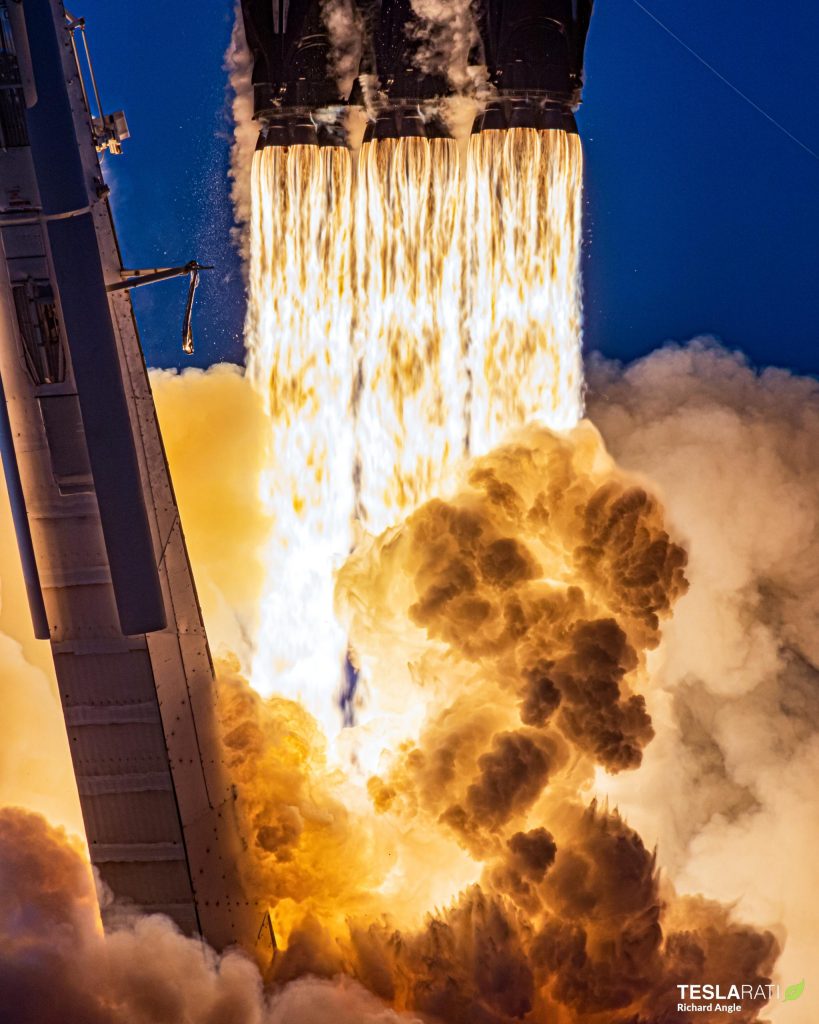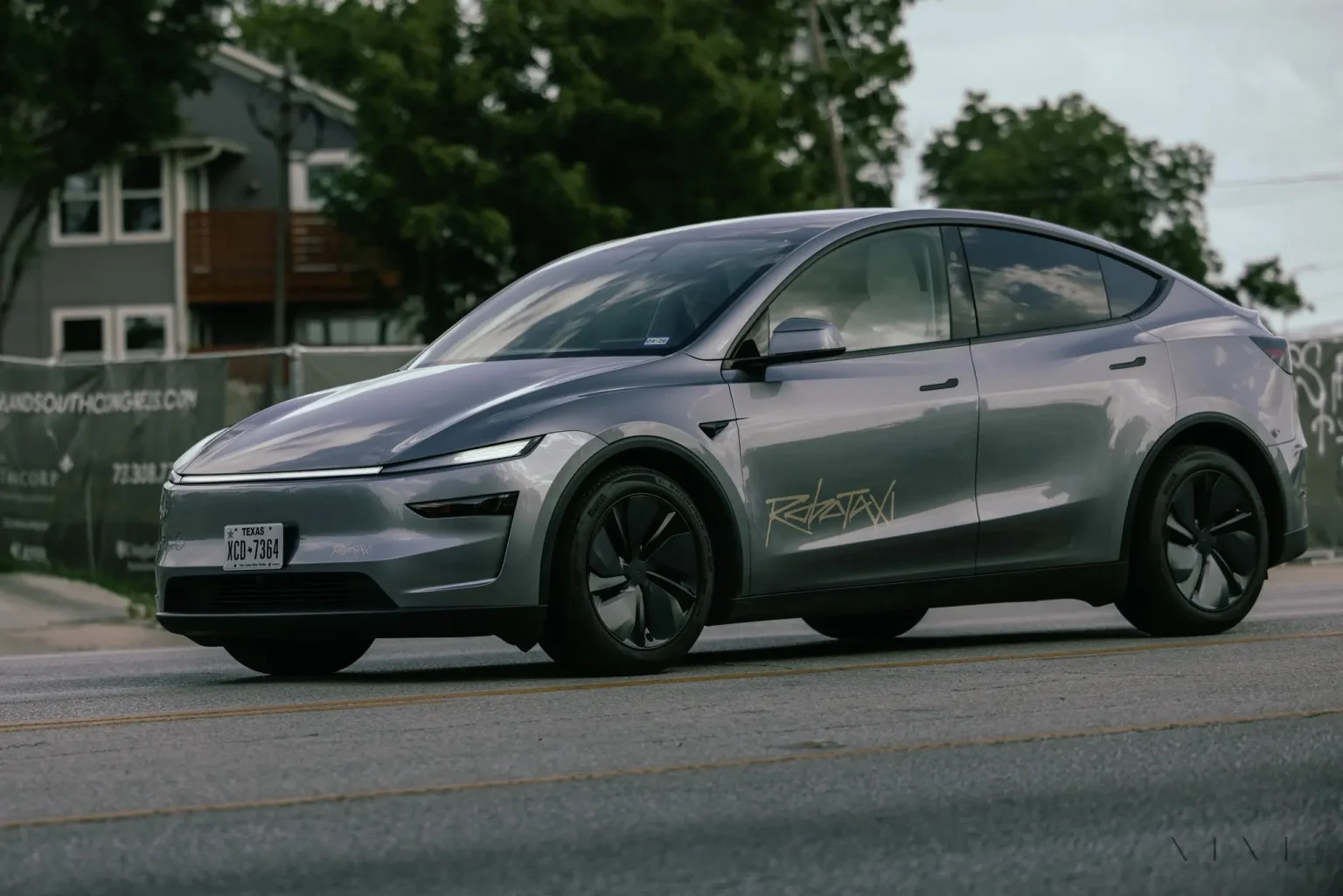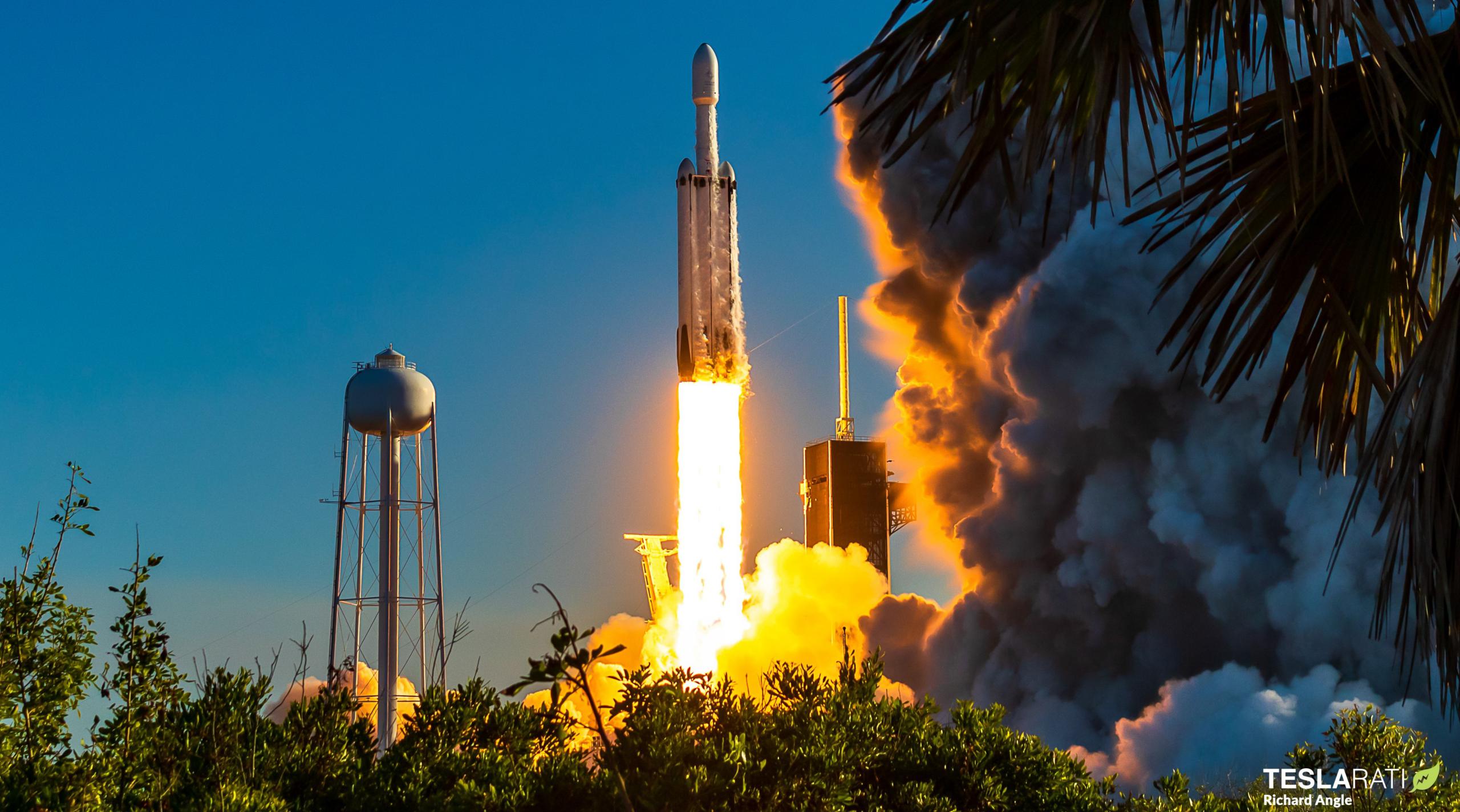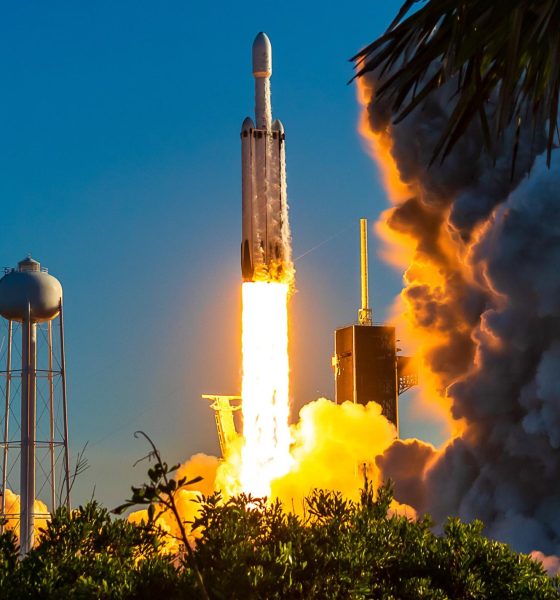In a statement issued to Bloomberg, the US Space Force says that SpaceX’s Falcon Heavy rocket could still conduct its first operational launch for the military before the end of the year.
That’s a large downgrade from late 2021 and early 2022, when – lacking any new information from the US military – it appeared that SpaceX could launch up to three Falcon Heavy rockets for military customers over the course of the year. Around eight months later, the world’s most powerful and capable operational rocket – backed by a strong manifest of 11 firm launch contracts – hasn’t flown once since June 2019. At that time, the rocket’s next launch was already expected no earlier than late 2020 – a roughly 18-month gap.
Instead, thanks to largely unspecified problems that have relentlessly delayed the completion of the satellites Falcon Heavy is supposed to launch, the rocket’s fourth flight is now unlikely to occur less than ~40 months after its third. Thankfully, a new Space Force decision should at least dull the pain caused by the endless shuffling of Falcon Heavy’s near-term launch manifest.
Alongside a slight schedule update stating that SpaceX’s first operational Falcon Heavy launch for the US military could still happen sometime from “October to December” 2022, the Space Force statement issued to Bloomberg mainly revealed the military branch’s June decision to permit SpaceX’s use of reused Falcon Heavy boosters on upcoming launches. While Bloomberg did not publish the statement in full or explain what the decision truly entails, the implication is that the Space Force will now let SpaceX assign flight-proven Falcon boosters – with US military oversight – to its military missions.
The US military will likely retain the ability to veto or modify SpaceX’s booster assignments and reuse sequencing, but the Space Force told Bloomberg that it’s confident that the “recovery, refurbishment, and launch of SpaceX boosters utilizes well-established processes.” In fact, the US military has already approved the use of flight-proven Falcon 9 boosters, several launches of which have since occurred, and even allowed SpaceX to fly two reused Falcon Heavy side booster’s on the rocket’s first (test) launch for the military.
It’s no surprise that that acceptance would eventually grow to include Falcon Heavy, which is similar to Falcon 9 in many ways. That it took the USSF until June 2022, three full years after STP-2 demonstrated the successful reuse of two Falcon Heavy boosters at once, to fully approve it is arguably far more surprising.

SpaceX will likely be able to plan for future Falcon Heavy launches more easily knowing that the US military should – in theory – be okay with the company reusing boosters on upcoming launches. That would be especially true if the military is comfortable with SpaceX reusing Falcon Heavy boosters that have supported non-military launches. After numerous delays, only one non-military mission – ViaSat’s first ViaSat-3 geostationary communications satellite – still claims to have a shot at a 2022 launch, but that target has slipped from spring, late-summer, and September 2022 to Q4 2022 since late 2021.
At one point, the US military’s USSF-44, USSF-52, and USSF-67 missions were all scheduled to launch on Falcon Heavy in 2022. Now, one reliable source states that USSF-44 and USSF-52 are indefinitely delayed, while another indicates that USSF-44 has slipped to December 2022 and USSF-52 to April 2023. Meanwhile, EchoStar’s Jupiter-3 commsat recently slipped to Q1 2023 and NASA’s Psyche asteroid explorer ran into software issues that delayed its Falcon Heavy launch from August/September 2022 to July or September 2023.
That leaves ViaSat-3 and USSF-67, both of which could launch in Q4 2022. But given just how delay-ridden ViaSat-3 has been and how temperamental all military Falcon Heavy payloads have been, the most likely outcome may already be zero Falcon Heavy launches in 2022.

News
Tesla FSD fleet is nearing 7 billion total miles, including 2.5 billion city miles
As can be seen on Tesla’s official FSD webpage, vehicles equipped with the system have now navigated over 6.99 billion miles.

Tesla’s Full Self-Driving (Supervised) fleet is closing in on almost 7 billion total miles driven, as per data posted by the company on its official FSD webpage.
These figures hint at the massive scale of data fueling Tesla’s rapid FSD improvements, which have been quite notable as of late.
FSD mileage milestones
As can be seen on Tesla’s official FSD webpage, vehicles equipped with the system have now navigated over 6.99 billion miles. Tesla owner and avid FSD tester Whole Mars Catalog also shared a screenshot indicating that from the nearly 7 billion miles traveled by the FSD fleet, more than 2.5 billion miles were driven inside cities.
City miles are particularly valuable for complex urban scenarios like unprotected turns, pedestrian interactions, and traffic lights. This is also the difference-maker for FSD, as only complex solutions, such as Waymo’s self-driving taxis, operate similarly on inner-city streets. And even then, incidents such as the San Francisco blackouts have proven challenging for sensor-rich vehicles like Waymos.
Tesla’s data edge
Tesla has a number of advantages in the autonomous vehicle sector, one of which is the size of its fleet and the number of vehicles training FSD on real-world roads. Tesla’s nearly 7 billion FSD miles then allow the company to roll out updates that make its vehicles behave like they are being driven by experienced drivers, even if they are operating on their own.
So notable are Tesla’s improvements to FSD that NVIDIA Director of Robotics Jim Fan, after experiencing FSD v14, noted that the system is the first AI that passes what he described as a “Physical Turing Test.”
“Despite knowing exactly how robot learning works, I still find it magical watching the steering wheel turn by itself. First it feels surreal, next it becomes routine. Then, like the smartphone, taking it away actively hurts. This is how humanity gets rewired and glued to god-like technologies,” Fan wrote in a post on X.
News
Tesla starts showing how FSD will change lives in Europe
Local officials tested the system on narrow country roads and were impressed by FSD’s smooth, human-like driving, with some calling the service a game-changer for everyday life in areas that are far from urban centers.

Tesla has launched Europe’s first public shuttle service using Full Self-Driving (Supervised) in the rural Eifelkreis Bitburg-Prüm region of Germany, demonstrating how the technology can restore independence and mobility for people who struggle with limited transport options.
Local officials tested the system on narrow country roads and were impressed by FSD’s smooth, human-like driving, with some calling the service a game-changer for everyday life in areas that are far from urban centers.
Officials see real impact on rural residents
Arzfeld Mayor Johannes Kuhl and District Administrator Andreas Kruppert personally tested the Tesla shuttle service. This allowed them to see just how well FSD navigated winding lanes and rural roads confidently. Kruppert said, “Autonomous driving sounds like science fiction to many, but we simply see here that it works totally well in rural regions too.” Kuhl, for his part, also noted that FSD “feels like a very experienced driver.”
The pilot complements the area’s “Citizen Bus” program, which provides on-demand rides for elderly residents who can no longer drive themselves. Tesla Europe shared a video of a demonstration of the service, highlighting how FSD gives people their freedom back, even in places where public transport is not as prevalent.
What the Ministry for Economic Affairs and Transport says
Rhineland-Palatinate’s Minister Daniela Schmitt supported the project, praising the collaboration that made this “first of its kind in Europe” possible. As per the ministry, the rural rollout for the service shows FSD’s potential beyond major cities, and it delivers tangible benefits like grocery runs, doctor visits, and social connections for isolated residents.
“Reliable and flexible mobility is especially vital in rural areas. With the launch of a shuttle service using self-driving vehicles (FSD supervised) by Tesla in the Eifelkreis Bitburg-Prüm, an innovative pilot project is now getting underway that complements local community bus services. It is the first project of its kind in Europe.
“The result is a real gain for rural mobility: greater accessibility, more flexibility and tangible benefits for everyday life. A strong signal for innovation, cooperation and future-oriented mobility beyond urban centers,” the ministry wrote in a LinkedIn post.
News
Tesla China quietly posts Robotaxi-related job listing
Tesla China is currently seeking a Low Voltage Electrical Engineer to work on circuit board design for the company’s autonomous vehicles.

Tesla has posted a new job listing in Shanghai explicitly tied to its Robotaxi program, fueling speculation that the company is preparing to launch its dedicated autonomous ride-hailing service in China.
As noted in the listing, Tesla China is currently seeking a Low Voltage Electrical Engineer to work on circuit board design for the company’s autonomous vehicles.
Robotaxi-specific role
The listing, which was shared on social media platform X by industry watcher @tslaming, suggested that Tesla China is looking to fill the role urgently. The job listing itself specifically mentions that the person hired for the role will be working on the Low Voltage Hardware team, which would design the circuit boards that would serve as the nervous system of the Robotaxi.
Key tasks for the role, as indicated in the job listing, include collaboration with PCB layout, firmware, mechanical, program management, and validation teams, among other responsibilities. The role is based in Shanghai.
China Robotaxi launch
China represents a massive potential market for robotaxis, with its dense urban centers and supportive policies in select cities. Tesla has limited permission to roll out FSD in the country, though despite this, its vehicles have been hailed as among the best in the market when it comes to autonomous features. So far, at least, it appears that China supports Tesla’s FSD and Robotaxi rollout.
This was hinted at in November, when Tesla brought the Cybercab to the 8th China International Import Expo (CIIE) in Shanghai, marking the first time that the autonomous two-seater was brought to the Asia-Pacific region. The vehicle, despite not having a release date in China, received a significant amount of interest among the event’s attendees.










